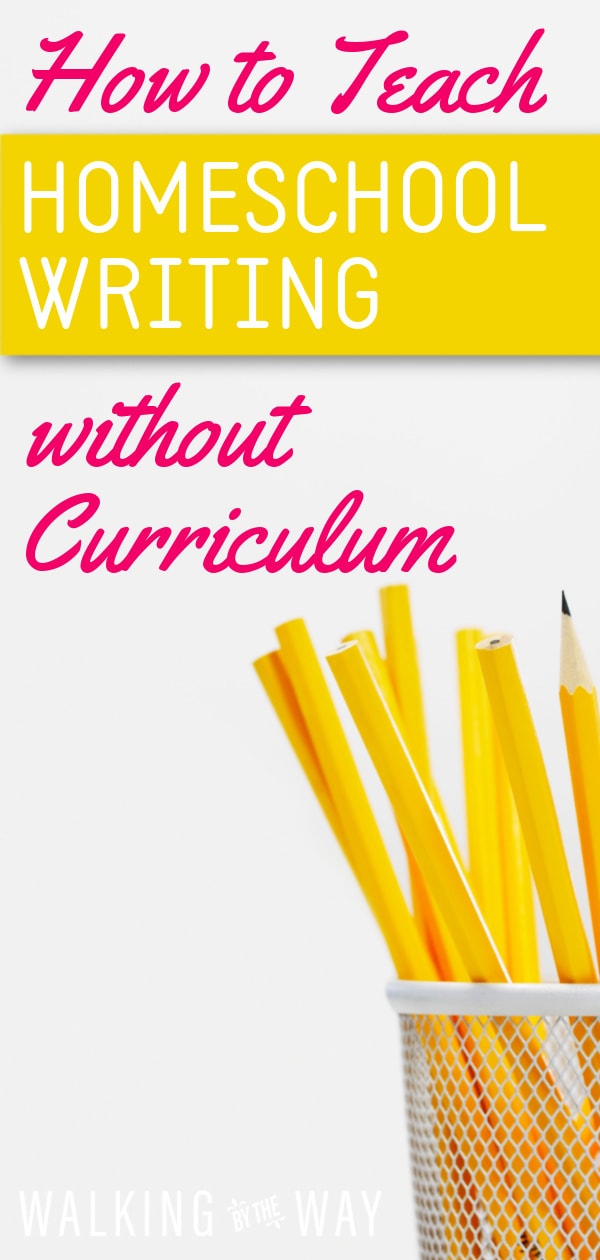Once upon a time I taught students how to write. High school students. Middle school students. I was an English teacher. I hate to admit this piece of trivia because I overuse clichés. I misuse commas. I abuse prepositions. And I have a fragment habit.
It can be embarrassing to announce this to the whole wide web. However, for today’s topic it’s necessary. It gives me some sort of authority on the topic—even if it’s just a sliver.
Dozens of students who came to my classroom at 15, 16, or 17 years of age could not write a complete sentence or a coherent paragraph. This was a mystery to me. Starting in first grade, they were taught noun + verb = sentence. The local elementary schools boasted about their writing workshops, but these high school students could not write.
So when I began homeschooling, I pondered how I would implement language arts. I don’t have much experience teaching writing to elementary school students, but I saw firsthand that elementary school practices were not producing great writers. Or even okay-ish writers.
I started thinking about the stories we often receive from first graders. Something like this:
Once upon a time there was a girl. The girl met a cat. They walked home. The End.
Where is the plot? Where is the conflict? Where is the setting and character development? Why do they write three sentence stories?
Because their little hands hurt, that’s why. Because it is a struggle to pen the words to paper.
So, here’s my first secret about how to teach your kids to be good writers.
Secret #1: Boycott required writing.
That’s right. No writing required.
When my boys were small, all of their stories were dictated to me while I typed for them. We printed them. We made them into books, and they could illustrate their stories if they wanted. No hurting hands. No tears. No ridiculous tales without characters or conflict. And most importantly—no negative feelings about writing.
Another reason young writers may struggle with writing is because they haven’t been exposed to good stories. By “exposed” I mean they haven’t read great writing. By “read great writing” I mean no one has read it to them.
Secret #2: Read aloud.
Read. And read. And read some more. And don’t pick junk. Choose great stories that keep you wanting to read–great stories that keep them wanting to listen. If you can’t bear to read, don’t worry, you have an out: audio books. I’ve used plenty of those, too, and listened alongside my kids.
It sounds crazy, but the bulk of our “writing curriculum” has simply been reading aloud and allowing the boys to hear sentence patterns, syntax, and character voices. Listening to great writing has taught them how to write.
But what about grammar? Don’t we need to be learning direct objects and diagramming and making sure our participles aren’t dangling? Well, in my opinion, no.
Secret #3: Resist the urge to start grammar lessons.
I cringe when I hear someone say, “My kids hate grammar.” I walked out of a homeschool workshop when the speaker admitted her students hated this “necessary” subject; her first and second grade students would cry through grammar lessons. I cannot be convinced a young child needs grammar instruction.
Instead of grammar exercises, I chose copywork for my boys. Copying inspiring quotes and great literature provides an amazing foundation for a future writer. And as soon as I knew they were ready, my boys began editing practice with Daily Paragraph Editing exercises (and occasionally with our local newspaper).
I did teach Elijah grammar when he got to junior high. Guess what? He grasped it quickly and for the most part it was painless. I am thankful we waited, and I don’t plan on changing it up for Simon.
Secret #4: Formal writing programs can wait.
There. I said it. Formal writing programs can wait until junior high.
And I can hear the string of “but-but-buts” from the Midwest Homeschool Convention to the classical practicum trainings.
Here’s the thing: my boys enjoy writing.
Both boys.
My boys are both good writers.
Yes, both boys.
Here is a snippet from the beginning of one of Simon’s stories (he wrote this when he was 9):
Once upon a time there was an alley. And in that alley there was garbage. And under that garbage there was a door. And the door led to a dusty room. And in that room lived a thief.
Maybe you think it’s rubbish, but I think it’s amazing, and it certainly beats the girl and the cat story. Elijah is also an excellent writer (fiction and nonfiction).
Okay, so I know the question that’s coming.
Ami, if you don’t use writing curriculum, then what do you do?
- I use mini-lessons such as the ones I wrote for picture books.
- I use web based activities.
- We play games to promote language learning.
- Don’t forget: dictated stories, copywork, and Daily Paragraph Editing.
- And I keep reading aloud and downloading audio books.
I have recently started creating engaging writing products for kids. Here are a few:
- Roll to Write: Writing a Thank You Note
- Roll to Write: Silly Sentences
- Super Stories: 100+ Creative Writing Prompts
My goal is to have competent communicators who love to learn, and I believe we have accomplished that. So far, so good.
I give you permission to ditch the writing and grammar curriculums in elementary school—especially if you are trying to raise kids who love to learn.
You can find more ideas for writing on my Inspire Writing in Your Homeschool page.





Great postI
My son is 10 (4th grade) and struggles to write. Your ideas and reasoning gives me hope. What books do you recommend we read aloud?
Hi Autumn,
What are his interests?
We loved My Side of the Mountain, The Apple and the Arrow, The Lion’s Paw, Circus Mirandus, On the Edge of the Dark Sea of Darkness, The Green Ember (series), Toys Go Out (series), and The Chronicles of Narnia.
Those are just a few to get started! 🙂 I have a post about some funny books we enjoyed, too: http://www.walkingbytheway.com/blog/funny-chapter-books/
I hope that helps! 🙂
What curriculum did you use once in junior high? Thanks!
Hi Nicole,
My older son used IEW Level B for one year. I taught an essay writing class at co-op when he was in 9th grade. You may also want to check out WriteShop. My oldest son’s final writing class(es) will be at a local university for dual credit.
My younger son chose Cover Story for next year. We will probably use WriteShop Level 1 & Level 2 after that to prepare him for a dual credit composition course.